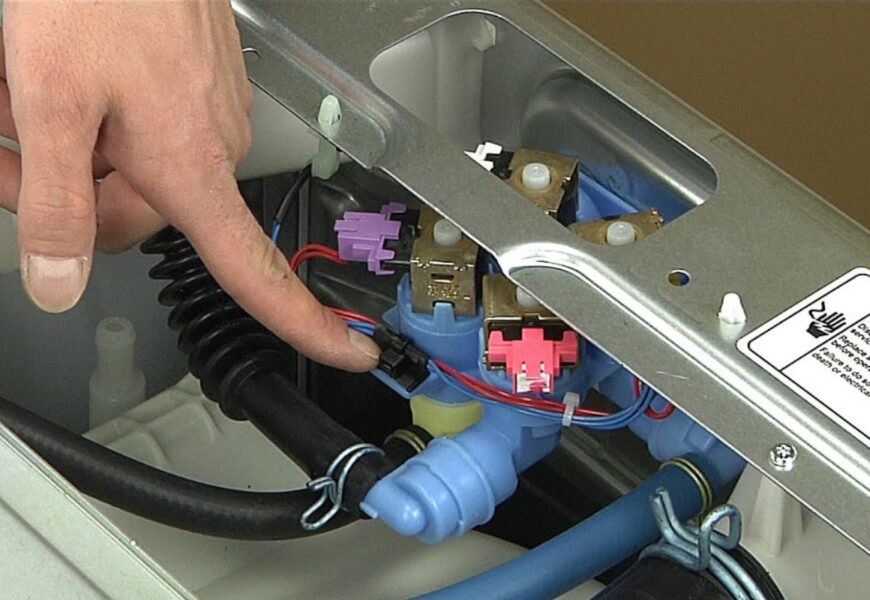Introduction
The water inlet valve is a key part of any washer, responsible for regulating hot and cold water flow into the drum. When it works correctly, the machine fills quickly and maintains proper water levels for cleaning. A malfunctioning valve can cause slow filling, no water entry, or continuous flow issues. With the right guidance, many water inlet valve washing machine problems can be fixed at home without costly repairs.
How a Washing Machine Water Inlet Valve Works
The water inlet valve washing machine plays a crucial role in controlling water flow during each cycle. It uses two solenoids, one for hot and one for cold water, to deliver the correct temperature mix. When the washer starts, the solenoids open to let water pass through the hoses. Once the right level is reached, the valve closes to prevent overfilling and ensure efficient washing.
Common Signs of a Faulty Water Inlet Valve
A failing water inlet valve often shows clear warning signs that affect your washer’s performance. You may notice the machine taking too long to fill, not filling at all, or continuously filling even when turned off. Sometimes, clothes may come out with detergent residue because insufficient water entered during the cycle. Unusual noises, like buzzing or humming, can also indicate valve issues. Recognizing these early symptoms helps you act quickly before the problem worsens.
Problems That Can Be Mistaken for Valve Issues
Not all filling problems are caused by a faulty inlet valve, so it’s important to rule out other possibilities first. Low household water pressure or clogged supply hoses can mimic valve failure by restricting water flow. A malfunctioning water level switch may also prevent the washer from filling properly, even when the valve is fine. Similarly, kinked hoses or a blocked pressure hose can lead to similar symptoms. Checking these areas can save time and unnecessary replacement of a working valve.
Preparing for Inspection and Repair
Before attempting to inspect or repair a washing machine water inlet valve, proper preparation is essential for safety and efficiency. Having the right tools and materials on hand will make the process smoother and prevent delays. It’s also important to follow safety measures to avoid accidents while handling electrical components and water connections. Taking these steps ensures you’re ready to troubleshoot confidently. Below are two key aspects to consider:
- Tools and Materials You’ll Need – Basic screwdrivers, pliers, a multimeter, replacement valve (if needed), and cleaning brushes.
- Safety Precautions Before You Begin – Unplug the washer, turn off water supply, and keep the work area dry to prevent shocks or leaks.
Check the Water Supply and Pressure
The first step in diagnosing inlet valve issues is to ensure the washer is actually receiving enough water. Start by confirming that the household water supply is turned on and the hoses connected to the machine are not kinked or blocked. Low water pressure in your home can also prevent the valve from opening properly, leading to slow filling. A quick test is to run water from a nearby tap to see if the flow is strong and steady. If the supply or pressure is inadequate, fixing this may solve the problem without touching the valve.
Inspect Filter Screens for Sediment Blockages
Most washing machine water inlet valves are fitted with small filter screens that catch dirt, sand, or mineral deposits from the water supply. Over time, these screens can become clogged, restricting water flow into the machine and creating symptoms similar to a faulty valve. To check them, disconnect the hoses and carefully remove the screens for inspection. If buildup is present, gently clean them with a soft brush or rinse under running water. Regularly cleaning these filters helps maintain smooth water flow and prevents unnecessary valve replacement.
Examine the Water Inlet Valve for Damage
After checking the filters, closely inspect the water inlet valve itself for visible signs of wear or damage. Cracks in the valve body, corrosion around the connections, or leaks near the fittings often indicate that the part is failing. Sometimes, mineral deposits can build up inside the valve, restricting movement and reducing water flow. If you notice any burnt smell or discoloration near the solenoids, it may point to electrical failure. Identifying these issues early can help you decide whether cleaning or full replacement is necessary.
Test the Valve Solenoids with a Multimeter
To confirm whether the water inlet valve is functioning properly, you’ll need to test its solenoids using a multimeter. Disconnect the washing machine from power, remove the valve connections, and set the multimeter to the resistance (ohms) setting. Each solenoid should show a specific resistance range; if the reading is zero or infinite, the solenoid is defective. This test helps distinguish between electrical failure and simple blockages in the valve. Accurate testing ensures you only replace the valve when it’s truly necessary.
Fixing or Replacing a Water Inlet Valve
If testing confirms the valve is faulty, the best solution is to replace it with a new one to restore proper water flow. The process is straightforward but requires careful handling to avoid damaging hoses or electrical connectors. Removing the old valve and installing the new one can usually be done with basic tools at home. Following the steps correctly ensures the washer runs smoothly again without leaks or filling issues. The process includes:
- Removing the Old Valve – Unplug the washer, disconnect hoses and wires, then unscrew and gently remove the faulty valve.
- Installing the New Valve – Position the replacement valve, secure it with screws, reconnect hoses and wires, then test the machine for proper water flow.
Troubleshooting Issues After Replacement
Sometimes, even after installing a new water inlet valve, the washing machine may still show problems like slow filling, leaks, or unusual noises. In such cases, double-check that all hoses and electrical connections are secure and tightened properly. Ensure the filter screens and water supply lines are clean and free from blockages. If the washer continues to malfunction, the issue may lie in related parts such as the water level switch or control board. Careful troubleshooting prevents repeated repairs and ensures lasting performance.
Preventive Maintenance Tips to Extend Valve Life
Taking care of a water inlet valve washing machine is simple with regular upkeep. Clean the filter screens often to prevent dirt and sediment from blocking water flow. Inspect hoses for leaks or kinks that could strain the valve. In hard water areas, consider a water softener to reduce mineral buildup and keep the valve functioning longer.
When to Call a Professional Technician
While many water inlet valve problems can be fixed at home, some situations require expert support. If your water inlet valve washing machine continues to have filling issues after replacement, the problem may be linked to wiring or the control board. Persistent leaks or hidden damage also signal the need for a technician’s inspection. Professional repair ensures safety, accuracy, and long-lasting machine performance
Easy Fix Reminders
Fixing a washing machine water inlet valve may sound technical, but with the right steps, it’s a manageable task for most homeowners. Starting with simple checks like water supply, pressure, and filter screens often resolves the issue without needing a full replacement. When replacement is necessary, carefully following the process ensures reliable results and prevents leaks. Regular maintenance can keep the valve working smoothly and extend the washer’s life. With these easy fix tips, you can save money on repairs and keep your laundry routine stress-free.
Conclusion
A properly functioning water inlet valve is essential for smooth washing machine performance, ensuring the right amount of water flows in during each cycle. By learning how to identify problems, carry out simple checks, and replace faulty parts, you can often solve issues at home without costly service calls. Regular cleaning of filters and maintaining good water pressure also helps prevent future troubles. If problems persist beyond basic fixes, calling a technician is the safest option. With these easy tips, handling a water inlet valve washing machine repair becomes far less intimidating.
Also, read: How to Seal Grout in Your Home: Easy DIY Guide















